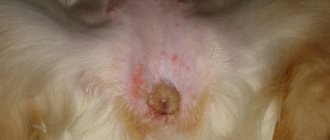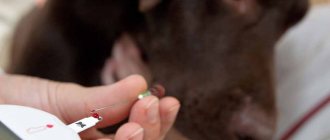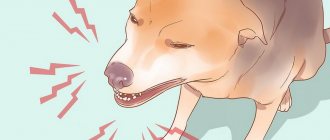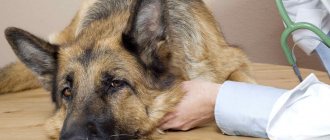When your dog's vestibular system is not functioning properly, he will not know whether he is sitting or standing, and this will cause him to feel dizzy and nauseous. You'll likely notice more than just a tilted head, since a tilted head is usually accompanied by other more noticeable signs, such as incoordination, abnormal eye movements, and vomiting. If you notice that your dog has any of these signs, you should take him to your veterinarian as soon as possible.
Dogs that tilt their head may be acting silly or trying to hear something, but if you notice your dog tilting his head all the time, he may have a medical condition such as vestibular disease. This condition affects your dog's balance due to a problem with his vestibular system, which tells the brain whether your dog is lying, sitting, standing, or falling. When the vestibular system is not working properly, it cannot detect head position or send messages to the brain. There are two types of vestibular diseases, which include central vestibular disease (an abnormality in the brain) and peripheral vestibular disease (an abnormality in the ear).
Causes of vestibular syndrome
Vestibular syndrome is often caused by degenerative diseases. Congenital anomalies usually appear in young dogs and are associated with deafness. If vestibular syndrome is caused by degenerative diseases, then its main symptoms usually include wide placement of the animal's limbs and movement of the head from side to side.
On a note! Most often, congenital anomalies of the vestibular apparatus are found among German shepherds and English cocker spaniels.
Vestibular syndrome is divided into different types, depending on the causes:
- Metabolic. Often, a disorder of the vestibular apparatus develops against the background of hypothyroidism. In this case, a specific symptom is positional strabismus (strabismus). Dogs suffering from metabolic vestibular syndrome often have a decreased palpebral reflex (the contraction of the orbicularis muscle when the eyelid is touched);
- Neoplastic. Another possible cause of vestibular disorder in dogs is neoplasms. They cause incoordination and unsteady gait of the animal due to compression or invasion of the vestibulocochlear nerve. Tumors can be primary or secondary. The prognosis depends on the location and type of tumor;
- Inflammatory. A common cause of vestibular syndrome in dogs is ear inflammation. External otitis, which occurs due to various factors (for example, allergies, parasites or foreign bodies) develops into internal otitis. This is what causes a dog to exhibit various symptoms of vestibular disorder;
- Toxic. A characteristic feature of toxic vestibular syndrome is its acute, progressive development. It is usually caused by intoxication with metronidazole, the use of aminoglycosides (a group of natural and semi-synthetic antibiotics) and various medications intended to clean the ears of an animal;
- Idiopathic. This group includes vestibular syndromes, the exact cause of which cannot be found. Idiopathic disorder occurs in dogs of different ages and breeds without an obvious cause. It is one of the most dangerous forms of the syndrome, because it is very difficult to select adequate therapy for no apparent reason.
Treatment for vestibular syndrome in dogs depends on what caused it (for example, abuse of special ear cleaning products or hormonal changes).
The animal tilts its head to the side
If a pet tilts its head to the side , you should think about what it is: a manifestation of curiosity and attention or a painful condition.
A change in head position accompanied by other signs of distress is a serious cause for concern and requires immediate attention to a veterinarian.
Why does the animal tilt its head to the side?
To find out the cause, you need to examine your pet, paying attention to the eyes, ears, and neck.
Inflammation of the middle ear (otitis media)
The disease is caused by pathogenic microflora, blood-sucking parasites (small mites) and a fungus that attacks the tissue of the ear canal.
If there are general signs of malaise (lethargy, refusal to feed, fever, discharge from the ear) and the pet constantly shakes its head, then the internal parts are involved in the process.
The vestibular apparatus, responsible for the sense of balance, is connected to the inner ear. Inflammation and swelling of the tissues affect its functioning, causing the position of the head to be disrupted.
Often the disease is accompanied by discharge that is purulent in nature and has a putrid odor, as well as redness of the hearing organ. Palpation may cause pain.
A general infection should be excluded, the signs of which are:
- oppression
- lack of appetite
- heat
- vomiting, diarrhea
- discharge from ears, eyes, nose
- skin changes
Presence of a foreign object
If a foreign body gets into the auricle, it is also possible to change the position of the head, since the foreign agent (small objects, tumors) causes discomfort.
Insects often enter the ear, moving deep inside. The animal scratches the ear, trying to get rid of it, but the deeper the foreign body is, the more the pet injures the organ, which further leads to inflammation.
The presence of foreign agents in the organ of hearing also causes an unnatural position of the head and shaking of the ears.
Ear mites
Infection of the auditory canal by blood-sucking parasites is a common occurrence in animals. Arachnids feed on blood and dead epithelial cells, damaging the surface of the ear and causing itching.
In this regard, the mammal scratches its ears, further injuring the surface, and when pathogenic microflora attaches, a combined infection develops.
The inflammatory process against the background of parasitic mites poses a threat to life, since waste products of parasites and bacteria enter the membranes of the brain through the bloodstream, leading to severe illness and death.
Allergic reaction
With many atypical reactions of the body, itching occurs, forcing four-legged animals to scratch themselves. The pathology is caused by foods, medications, and environmental agents (pollen, dust).
Allergens cause a specific reaction in the body, accompanied by swelling, itching, and the appearance of a rash. The mammal shakes its head, tilts it to the side, and scratches the ear canal, injuring it and introducing dirt.
Pyogenic bacteria entering through damaged skin cause inflammation not only of the outer parts of the ear, but also of the internal ones.
Diseases of the middle and internal sections lead to impaired coordination of the animal and changes in head position.
Cerebrovascular accident
Often tilting to the side indicates brain damage. It is worth paying attention to the symmetry of the pupils and their reaction to light (asymmetry is a sign of cerebrovascular accident).
If nothing is found during examination, it may be due to a recent traumatic brain injury.
This condition cannot be ignored, since a change in head position indicates pathological processes in the brain (bleeding, neoplasm, dysfunction of neurons).
Other reasons why an animal tilts its head to one side
You should also pay attention to how your four-legged pet keeps its balance. Changes in coordination of movements may be due to dizziness, or associated with weakness in the limbs.
If at the same time the eyes “run” from side to side, or up and down, this is nystagmus. Normally, it is observed for a short time after sudden circular movements of the head. If nystagmus is present even at rest, consult your veterinarian immediately.
Help your pet
If the tilt persists for several days, the animal is restless or has poor balance, call a veterinarian at home.
Inflammatory processes in the ears can cause serious consequences (meningitis) and death.
Cerebrovascular accident is a serious problem leading to pet disability and death.
You should not use medications yourself without finding out the cause of the disease, this will aggravate the severity of the disease.
Only a doctor, after conducting an examination and additional research, can accurately establish a diagnosis and prescribe the correct treatment. The faster veterinary care is provided to the injured pet, the higher the chance of recovery.
The main symptoms of the disorder: a useful reminder
10 symptoms that will help you promptly recognize vestibular syndrome in a dog and contact a veterinarian:
- Pronounced tilt of the head.
- Staggering when walking, inability to walk in a straight line.
- Frequent falls.
- Unnaturally wide arrangement of front and rear labia.
- Loss of coordination in space.
- "Tipping" the pet to one side.
- Nystagmus is an uncontrollable tremor and twitching of the eyeballs.
- Attacks of vomiting due to dizziness.
- Problems with appetite, thirst.
- Decreased activity.
In severe cases, pets completely refuse food and water. They stop moving and begin to walk under themselves. It is important not to bring the situation to such a state, but to promptly seek veterinary help in Moscow!
Signs of hydrocephalus
The age at which symptoms first appear can vary, on average from 2 months to 5 years, but owners of animals under the age of 1 year most often seek help.
The most characteristic clinical signs of hydrocephalus include seizures and/or unusual behavior of the animal, for example:
- the dog runs in circles (as if chasing its tail);
- throws his head back;
- or tilts it to one side;
In addition, hydrocephalus is indicated by the characteristic appearance of the dog, which distinguishes it from its littermates:
- a very large skull on a thin neck;
- strabismus of the eyeballs;
- behavioral disorders (aggression, bulimia, increased libido, difficulties in training).
Chihuahua with signs of hydrocephalus
If you notice such deviations, you urgently need to take the animal to a veterinary clinic for a comprehensive examination.
Forms of vestibular syndrome
Vestibular syndrome in dogs affects either the peripheral or central vestibular system. Depending on this, it is divided into two different forms, each of which has its own characteristics:
| Peripheral vestibular syndrome | The causes of the peripheral vestibular apparatus are often congenital anomalies, injuries to the temporal bone, or intoxication (for example, antibiotics). |
| Central vestibular syndrome | Brain diseases lead to the development of this form of vestibular syndrome. They may be infectious (eg, toxoplasmosis) or vascular (eg, ischemic stroke). Central vestibular disorder can be caused by brain tumors (for example, lymphomas), as well as inflammation of the nervous system. |
Diagnostics
Treatment of vestibular syndrome in dogs begins with diagnosis. To do this, the veterinarian collects anamnesis to find out what factors provoked the development of a disorder of the vestibular apparatus. Additionally, a general and biochemical blood test, magnetic resonance imaging (MRI), X-ray and ultrasound examination of the animal’s internal organs and head are prescribed. Separately, the veterinarian examines the condition of the dog’s middle and inner ear.
On a note! If necessary, a bacteriological examination of the contents of the middle ear is prescribed.
Preventive measures
Since a heart attack for an animal is a serious stress that causes irreparable harm, everything must be done to avoid such an event. The main preventive measures are annual diagnosis and testing to know the state of the cardiovascular system and possible heart problems.
To do this, you need to constantly use a special balanced food in the animal’s diet, which contains a sufficient amount of vitamins and microelements. Be sure to constantly monitor your pet's activity.
Currently reading:
- Actions to take in case of an epileptic attack and a shaking dog
- Ways to Treat Asthma Symptoms in Dogs in 2022
- Detection of endocardiosis and its treatment in dogs
- Seven Signs and Remedies for Getting Rid of Fleas in Dogs
Treatment of vestibular syndrome
With vestibular syndrome in a dog, two situations are possible. The first is when the cause of the disorder is known (for example, trauma or inflammatory disease). The second is idiopathic vestibular syndrome, when the cause of the lesion is not identified.
In the first case, when the cause is precisely known, the veterinarian prescribes therapy aimed at eliminating it. The main methods of treatment include the use of systemic antibiotics and lavage of the middle ear, surgical removal of tumors, discontinuation of aminoglycosides, etc.
On a note! The main thing with vestibular syndrome is to eliminate the cause that led to its development. Usually this is enough for the dog’s condition to improve, dizziness and other symptoms of the disorder to go away.
In the second case, when a dog is diagnosed with idiopathic vestibular syndrome, it is impossible to select a specific treatment. The use of corticosteroids does not improve the animal's condition. Only supportive treatment (eg, nausea and vomiting) is used.
In approximately 60% of cases, a dog with idiopathic vestibular syndrome improves within 3-5 days, and returns to normal after 2-3 weeks. However, in some animals the head tilt remains even after other signs of the disorder have subsided.
In both cases, regardless of whether the cause of the vestibular disorder is known, supportive therapy is used. It involves various physiotherapeutic procedures that will help the dog’s body recover faster from the disorder.
Treatment method and prognosis
Treatment of vestibular syndrome is not possible in all cases. So, if we are talking about the idiopathic nature of the pathology (congenital or acquired with age), medications are prescribed to alleviate the animal’s condition.
Pathology caused by an inflammatory infectious process is treated with antibiotics (broad-spectrum). When treating otitis, it is prohibited to use ototoxic drugs belonging to the group of aminoglycosides (antibiotics, chlorhexidine).
Vestibular syndrome caused by oncology can only be eliminated by surgery and chemotherapy. For hypothyroidism and other hormonal disorders, it is advisable to use replacement therapy.
With timely treatment, the dog’s condition stabilizes within three days. After 1-2 weeks, a decrease in ataxia and head tilt can be observed; after 3-4 weeks, recovery occurs. At this stage, physical therapy is prescribed. However, it would be incorrect to talk about a final cure.
As for prognosis, a positive one is possible only if the syndrome was diagnosed in a small puppy - there is hope that its vestibular apparatus will adapt to the environment, and the baby will be able to live a full life. In other cases, this is especially true for cancer patients, residual effects cause the animal to suffer for the rest of its life.
Forecast
For vestibular syndrome in dogs, the prognosis largely depends on the cause of the disorder. If the disorder is caused by abuse of ear cleaners or otitis media, the prognosis is positive. Another thing is neoplasms. For primary or secondary tumors, especially in the later stages of development, the veterinarian always gives a very cautious prognosis. With idiopathic vestibular syndrome, it is difficult to give a prognosis. The veterinarian will base it on the severity of the symptoms and the general condition of the animal.
First symptoms and changes in dog behavior
A sick dog can be easily distinguished from a healthy one:
- The dog behaves differently
- Trying to close himself in a dark place
- He lies down and doesn’t want to get up
- Doesn't make any sounds, but lies quietly
- Sad eyes
- Doesn't want to join the team
Only in some cases can you notice that the dog, on the contrary, has become hyperactive and aggressive. Doesn't want to stand or sit in one place, behaves strangely with people around him. Only the charter takes a lying and sitting position. Symptoms you may notice:
- Cowardice
- Wants to hide
- Howling with no reason
- Wants to bite, thereby annoying others.
- Aggression towards people around him
- Depressed mood
- Wants to bite for no reason
- Indifferent and excited
All these symptoms signal the urgency of treatment and rehabilitation in a medical institution. Otherwise, you can contact a veterinary pharmacy and the Gomeovet pet store.
Anyone who has a dog will probably notice changes in their pet's behavior. If some of the symptoms listed below intensify, immediate action must be taken.
What to do at home?
If you suspect that your dog has vestibular syndrome, then immediately contact a veterinarian in Moscow. Only a doctor can make an accurate diagnosis and prescribe effective treatment for the disorder.
While therapy is ongoing, it is in your power to help your pet recover faster. Provide him with a comfortable place to rest (for example, a soft lounger next to a bowl of water). To avoid injury if your animal falls, block the exit to the stairs from which it could fall and secure sharp edges of furniture.
If the dog can move independently, then do not carry it in your arms. The more the animal moves independently, the faster the inner ear will recover. Good lighting definitely contributes to recovery, so that the pet can clearly see the surrounding space.
Information about the violation
In fact, there is no single correct answer to the question of what ataxia is. The fact is that this cannot be called a single disease, since ataxia simply indicates the appearance of some symptoms, here is a list of them:
- loss of coordination, which occurs suddenly in all situations;
- situations involving loss of balance;
- sudden shaking;
- There are even situations when an animal falls for no reason.
Let's also mention the classification of ataxia, here are the main types:
- vestibular;
- sensitive;
- cerebellar
It is worth noting that each type has its own characteristic features, as well as reasons for its appearance. The first type of ataxia indicates disturbances in the functioning of the vestibular apparatus, which is necessary for the animal to successfully maintain balance; without it, it will be difficult for the dog to be in space. This will be expressed by the fact that she will not even be able to hold her head normally in one position, there will also be a slight list when walking, and instability will end with the dog constantly falling or even spinning in place. Experts note another characteristic symptom - uncoordinated eye movements, as well as a constant feeling of drowsiness, less often - numbness.
Sensitive ataxia
As for sensitive ataxia, it develops in cases of damage to the Burdach or Gaulle bundles, and it can also appear due to disorders in the spinal cord. The main sign of this type of ataxia is considered to be various disturbances in the process of walking; in most situations, owners notice that the dog begins to look at its feet all the time while moving. It is worth mentioning that with serious lesions, the dog may even lose the ability to be in the “standing” and “sitting” positions. For this reason, at the first manifestations, you must consult a doctor, do not hesitate!
Note! The previously discussed types of ataxia cannot affect various behavioral aspects of the pet. Thus, the dog’s behavior partially does not change; of course, the previously described disorders are observed, but this is not so serious (the problem can be solved by contacting a specialist, and mental abnormalities are not observed). For this reason, specialists can easily diagnose the disease, distinguishing it from various infections.
Since these pathologies are relatively minor, it is necessary to consider cerebellar ataxia, because it is the most difficult to treat, even with timely consultation with a specialist. If this area is damaged, the dog’s coordination of movements, as well as its balance, are significantly impaired. Even with a slight delay, loss of control over the pet’s motor function will follow. In more rare situations, more dangerous symptoms are observed, namely, a violation of the ability to spatial orientation; it is worth mentioning that sometimes dogs even cease to recognize their owners, as well as the place where they have always lived.
Such damage to the cerebellum, located in the brain, is often caused by a tumor, and occasionally an infection can be the cause. Despite this, in most situations such manifestations occur due to defects present from birth. The essence of the mentioned defects is that the death of normal neurons is caused. In such situations, the specialist makes a diagnosis called “hereditary cerebellar ataxia.”
Let us mention that such diseases are transmitted by a recessive gene, that is, such disorders must be present in both individuals participating in the birth of the animal. For this reason, cerebellar ataxia is considered a fairly rare disease, because conscientious breeders do everything possible to combat inherited diseases (dogs with such diseases are simply not allowed to breed).
Loss of coordination due to poisoning
Why dogs can still lose coordination - the reasons for the appearance of other types of illness The reasons for the development of loss of coordination can be different. As mentioned earlier, these types of disease develop against the background of damage to something. Most often, the main reason for their appearance is oncology; such a neoplasm can damage any important organs, which will be accompanied by a large number of unpleasant symptoms, the main ones of which have already been discussed in this material.
It is worth mentioning that the cause of poor coordination in dogs can also be the penetration of toxins into the body. It cannot be argued that this only means poison, since any substances that are released into the bloodstream by helminths (worms) can act as toxins. If a dog has large worms, the problem can be huge, because everything can turn into encephalopathy, so disorders associated with motor function are not the worst manifestation of helminths.
Despite this, the most common cause is poisoning. Almost all dogs pick up some things on the street, and in some situations you can come across poisoned bait, despite the fact that these days they are quite rare. In such situations, in the absence of medical assistance in the first few hours, everything will end up with much more serious manifestations, because, most likely, the pet will die.
The problem may also be due to autoimmune diseases; systemic lupus is most often to blame. Such an ailment has a characteristic feature because if it is present, the pet’s body will begin to destroy itself. Experts note that the nervous system may be the first system to be affected, which is why poor coordination of movements often develops.
Important! Don’t forget about injuries, since a dog that has been hit by a car can have a lot of serious injuries that can be observed throughout the body. In this case, ataxia is not uncommon. As you might guess, in this case it is very important to get the dog to a medical facility as quickly as possible. If the veterinarian does not look at it, then any hematoma in the meninges can lead to death!











